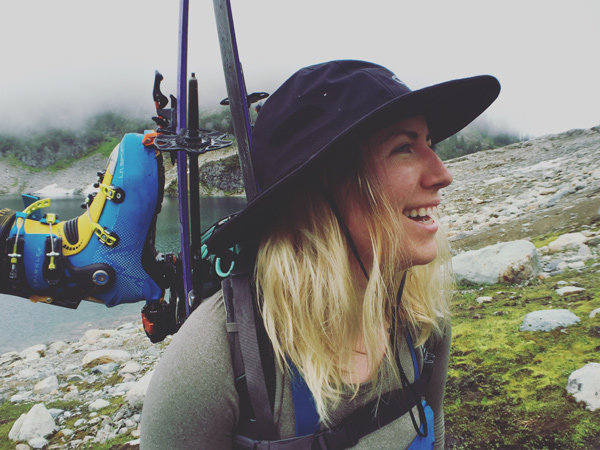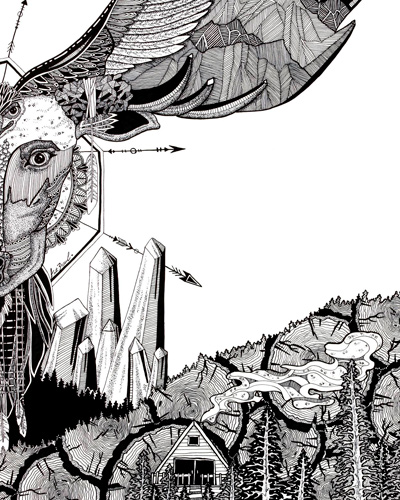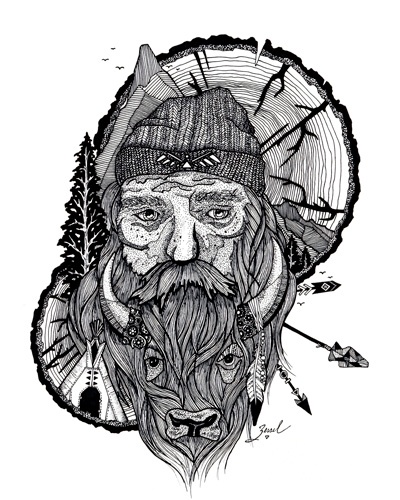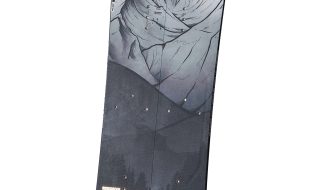Hailing from Whistler, B.C., 27-year-old artist Kate Zessel seems to have everything figured out. But her path to success hasn’t been a straight one; growing up, she wasn’t sure how to make art a viable profession. But the constant loves in her life—drawing and skiing—guided her in finding a way to make a living doing what she loves most. We talked with Zessel to learn about her accomplishments and how she balances work and play. Here’s what she had to say.

Title: Forget the World
Backcountry Magazine: Where did you get your start as an artist?
Kate Zessel: I’ve always created artwork—ever since I was very young. But it took me a while to figure out how to create a business and a lifestyle around it. I went to business school for two years and found myself creating art on my couch nonstop. When I realized that’s where I was investing my time, I decided to go to graphic design school and moved to Whistler.
My first break as an artist up here in Whistler was my friend Vicky telling me about the Prior contest. Local artists can submit artwork to go on skis and snowboards, and I ended up winning and having my work used as a topsheet graphic. Then I got my stuff in Mount Currie Coffee Company up in Pemberton. The owner, Chris, gave me a 30-foot wall to showcase my work. Since then, I’ve just kept going. At the beginning, I was focused on offering my style to people, getting my name out there, but not necessarily making a profit. I was barely breaking even on a lot of projects for a number of years. As I slowly built a network and a reputation here in Whistler, I started to realize that I could make a living at this.

Title: Grizzly
BCM: How has living in Whistler affected your artwork?
KZ: I grew up in Whistler and Vancouver. We were weekend warriors, so my dad would pile us into the car on Friday after he finished work and we would go to our cabin in Whistler we called the “Ice Palace,” because there was no heat—it was back in the ’90’s. My dad grew up skiing and knew that was my passion, so he had a 30cm rule with me that was unspoken. As soon as I got my driver’s license, I knew that as long as I stayed on honor roll, he’d let me go skiing on powder days. I always knew I’d move to Whistler, and I always felt like I was coming home every weekend. I didn’t feel like Vancouver was home for me, because I didn’t find a ton of inspiration in the city. I really enjoyed Whistler; I enjoyed the mountain-town vibe and I enjoyed slowing down, stepping outside and breathing and experiencing that mountain air and being able to have the mountains as my backyard instead of having to drive somewhere to get that experience. I think that’s what really drove my artwork and the style I have today.

Title: Whale of a Time
When I went to school in Victoria, I was still doing art, but it wasn’t the same style that I have now. I think that your life creates your artwork and your artwork creates your life. So wherever you are, that’s what you’re inspired by, and for me, if I don’t get into the mountains every week, I lose a part of myself. Every time I’m having a hard time, my friends say, “Hey, go summit something and all your problems will go away or become more clear.” For me, that’s where my whole body relaxes and I can fully visualize what I want. It’s the same with my artwork. If I can bring that feeling of connection into my artwork, people really resonate with it.

Title: Where We Belong
BCM: When did you start to backcountry ski, and how is it represented in your work?
KZ: I started skiing Whistler when I was two years old, and when I moved here I skied the resort all the time. That was my home, because that was my comfort zone. What I love about Whistler is that everyone talks about how it’s a bubble and how small it is, but it’s not. Whistler and the surrounding towns of Pemberton, Squamish and other places along the Sea to Sky corridor are amazing, and I wanted to take myself outside of that comfort zone and push myself more in mountains farther afield from Whistler.

Zessel gets out into the Whistler bc to clear her head and find creative inspiration. [Photo] Kurtis Gibson

Fuel for thought: Zessel takes in the view and has a snack mid skintrack. [Photo] Kate Zessel
BCM: What does your artistic process look like?
KZ: I don’t really have one. I think it’s different if it’s for a client or if it’s for a show I’m putting on myself. When it’s artwork for myself, I go out and spend time in the mountains—that part doesn’t change; I need that whether my work is for a client or myself—but I’ll go spend time in the mountains, come home and then pour that onto the page.
If it’s for a client, I have to put myself in their shoes and try to understand what their company values are and what they have asked me for. It’s easy if it’s mountain based or if it’s hut or tent related. But if they’re looking for more of an ocean vibe, I’ll go to the ocean and go kayaking or paddle boarding, and I try and resonate with what they’re asking for. Instead of just coming home from my adventure and pouring it all onto paper, I research what they’re asking and try to read articles and do a lot of background work on the company. My day will normally start with me going out in the morning for an adventure, and then easing back to my office. I start working around 1:00 p.m., and I end work around 1:00 a.m. So my hours are a bit different; I tend to be a night owl just so I can get outside while there’s daylight.

Title: Cabin Life
BCM: What is being a professional artist like?
KZ: I always joked with my brother that I would live in his basement and be an artist and take care of his kids. All of my family is in business and I’m an artist, so I never saw the profit in it—I didn’t know it could be profitable. My two passions have been adventure and drawing, so I would work two to three jobs to fulfill those passions. As my artwork started to grow and my platform and network started to grow, too, I was lucky enough to have clients approach me instead of the other way around. I slowly went from doing smaller projects or passion projects to bigger contracts. And I was worried that by turning my passion into a job I would ruin it. So finding that balance is really important to me. Once you invest all of your time into your passion, you can have incredible results, but you need to take time for yourself. I now have the ability to say no to the projects I don’t want to do—although I don’t think I’ve ever said no to something—but now it’s about managing my time so I can get everything done and make sure I can still get outside enough to enjoy the mountains I love.

Title: Old Man Winter\
—
See more of her artwork at zesseldesigns.com.











Related posts:
Skintrack Sketches: Brooklyn Bell finds her calling in art and the mountains
Skintrack Sketches: Skiing, art and loss through the eyes of Sandra Fransson
Skintrack Sketches: Artist Emma Longcope paints the public lands she protects by day
Skintrack Sketches: ACMG guide Aaron Enns zooms in on geometry to paint a bigger picture